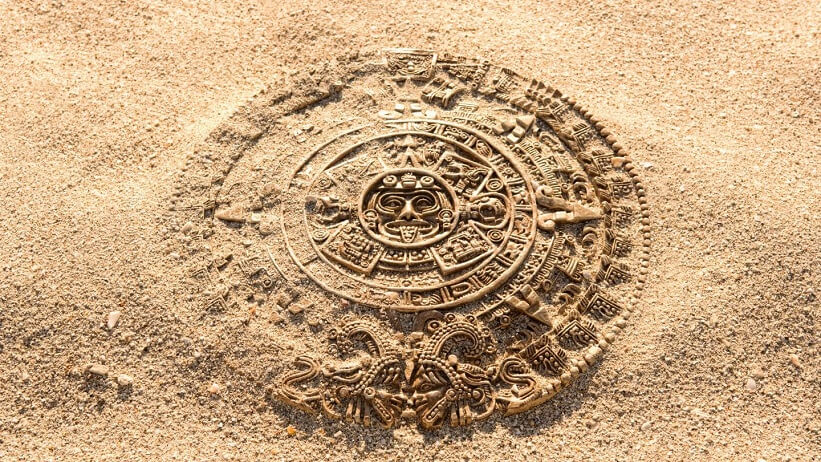
A Mysterious Mayan Calendar Stumped Scientists For Decades: “A New Study Has Cosmic Answers”
References to an ancient 819-day Mayan calendar have long puzzled researchers, who now say they've solved a major mystery.
By: Becky Ferreira | Vice
Scientists have solved a longstanding mystery about a Maya calendar that includes 819 days, an unusual number that has puzzled experts for decades, reports a new study.
A pair of anthropologists demonstrated that multiples of this number sync up with the rhythms of planets in the solar system that are visible to the naked eye, which underscores the astronomical sophistication of these ancient Pre-Columbian peoples.
Maya civilization first emerged more than 2,500 years ago and flourished across much of Central America until the arrival of Europeans in the 16th century. This powerful and long-lived Mesoamerican culture is famous for its monumental architecture, including ornate pyramids, ceremonial ball-courts, and causeways that stretch for miles across the landscape.
The Maya peoples also developed a complex written language and had an extremely advanced understanding of astronomy, mathematics, and agriculture, among other sciences. Though this Mesoamerican civilization has faded in recent centuries, modern Maya peoples still participate in traditional practices, and speak Mayan dialects, across Belize, El Salvador, Guatemala, Honduras, and Mexico.
Scientists Collect First RNA From An Extinct Tasmanian Tiger
Maya peoples used their vast natural knowledge to produce complicated calendars that tracked the motion of the celestial objects, the changing of the seasons, and the timing of ritual festivals. The most important calendar was the 260-day Tzolkin, but Maya researchers have also found references to an enigmatic 819-day calendar that has remained unexplained for decades.
Past researchers have suggested that the calendar may relate to the amount of time that it takes for a planet to appear in the same spot in the sky to an observer on Earth, known as a synodic period. This idea works well enough for Mercury’s synodic period of 117 days, which equals 819 when multiplied by seven, but seems to fall apart for the other planets.
Now, John Linden and Victoria Bricker, a team of anthropologists based at Tulane University, believe they have found the answer to this riddle. The researchers propose that “by increasing the calendar length to 20 periods of 819-days a pattern emerges in which the synodic periods of all the visible planets commensurate with station points in the larger 819-day calendar,” according to a new study published in Ancient Mesoamerica.
“Arguably the most enigmatic of the Maya calendar cycles, the 819-day count has challenged modern scholars for decades,” Linden and Bricker said in the study. “Even today it is not completely explained and there are several areas for further research, including its relationship with the synodic periods of the planets visible to the naked eye.”
“Earlier research has demonstrated a four-part, colour-directional scheme for the 819-day count such that each of the calendar stations progress in increments of 819 days in cycles of 4 × 819 days,” the team continued. “Although prior research has sought to show planetary connections for the 819-day count, its four-part, color-directional scheme is too short to fit well with the synodic periods of the visible planets.”
Instead of finding cycles that fit within the 819-day count, Linden and Bricker envisioned the calendar as one cycle in a much larger timescale. By multiplying this single unit of 819 days, it’s possible to produce elegant matches with the synodic periods of the planets. For instance, Mars’ synodic period of 780 days is equal to 20 times 819, while Jupiter’s 399 day period is equal to 39 times 819, and so on.
The proposed calendar even syncs up to the 260-day Tzolkin; if you multiply 819 days by 20, you get 16,380 days, or roughly 45 years. This period is equal to 63 times the 260-day calendar, suggesting that many of these timekeeping cycles were integrated with one another.
The new study provides a satisfying solution to the perplexing 819-day calendar, but it’s not likely to be the end of the story. Maya researchers are constantly discovering incredible details about this rich Mesoamerican culture that upend our current assumptions. While the riddle of this fascinating calendar may have been solved, many more mysteries about Maya culture remain.
* * *
NEXT UP!
Scientists Find Out If A Lashing Dinosaur Tail Could Generate A Sonic Boom
Every once in a while, scientists embark on a study to test some weird and wacky hypothesis that makes you wonder why. But let’s indulge them; it can be fun
A new study from a team of palaeontologists and aerospace engineers has simulated a dinosaur‘s tail as it lashes about, all to see whether long-necked sauropods could whip their appendages faster than the speed of sound – quick enough to produce the crack of a small, supersonic boom.
Previous research has suggested the dinos could, if their tails had a bullwhip-like structure adding length. If that were true, these herbivorous dinosaurs might have used their tails to defend themselves against predators or nosy neighbours.
* * *
READ MORE: This Could Be The Earliest Evidence of A 260-Day Maya Calendar Ever Found
Read more on The Maya Civilization: Were The Mayans Visited by Ancient Astronauts?
Telegram: Stay connected and get the latest updates by following us on Telegram!
We’d love to hear from you! If you have a comment about this article or if you have a tip for a future Collective Spark Story please let us know below in the comment section.
